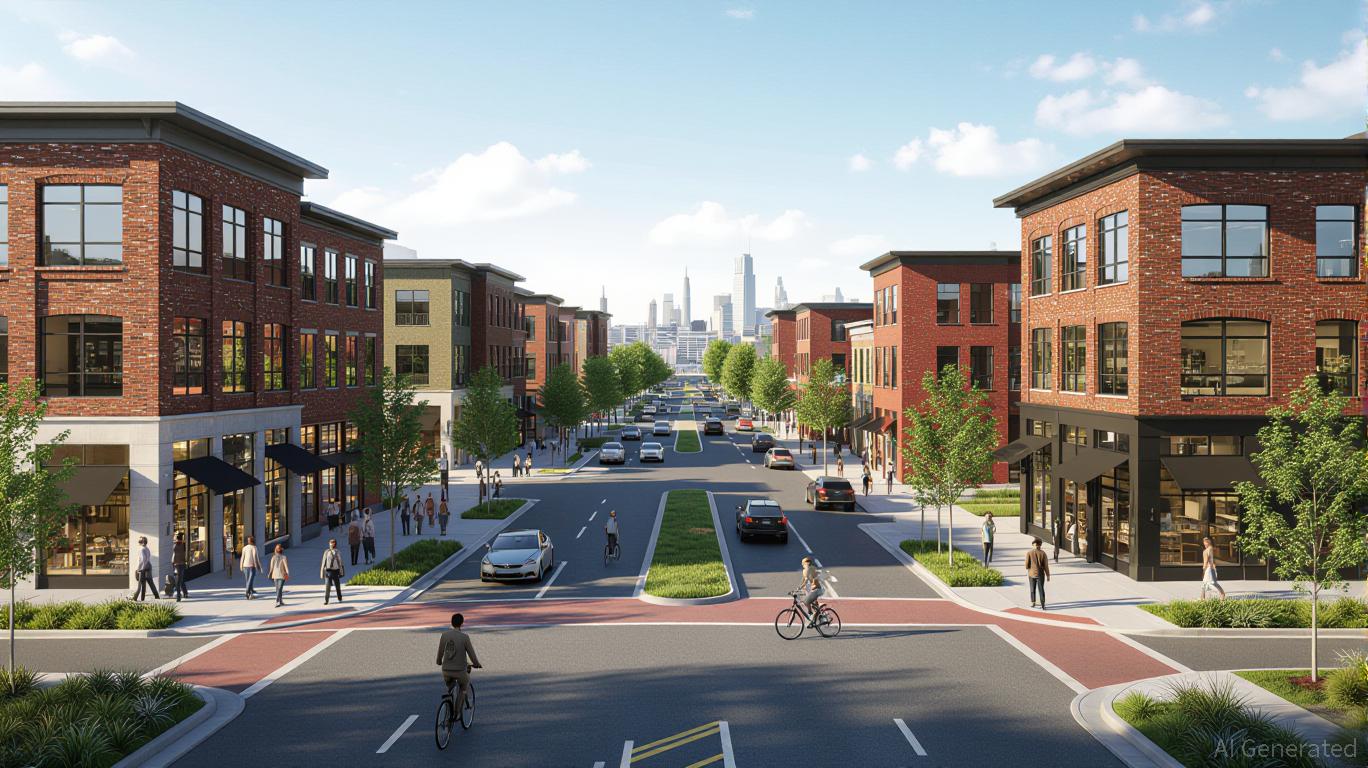Infrastructure-Connected Real Estate: Emerging Opportunities in Post-Industrial Zones
- Post-industrial corridors are becoming strategic real estate hubs through infrastructure upgrades and PPPs, driven by state funding and governance innovation. - Webster , NY secured $38M in grants (2023-2025) for transportation , wastewater, and downtown revitalization, repositioning industrial sites for mixed-use development. - Ohio's $100M Residential Development Revolving Loan Program and $121.5M Brownfield initiatives demonstrate state-level policy alignment with infrastructure-linked value creation.
The redevelopment of former industrial corridors into thriving centers for business and housing has shifted from a speculative idea to a necessary strategy. As cities throughout the United States transition from traditional manufacturing bases to more diverse, service-driven economies, real estate tied to infrastructure is becoming a prominent investment focus. This evolution is fueled by a combination of state funding initiatives, collaborations between the public and private sectors (PPPs), and progressive policy approaches. The example of

Webster, NY: A Model for Infrastructure-Driven Renewal
The Village of Webster stands out for its effective use of infrastructure grants to enhance real estate prospects. From 2023 to 2025, the village secured more than $38 million in combined state and federal support, aimed at both essential upgrades and economic growth. A $9.8 million FAST NY Grant is dedicated to improving transportation infrastructure at the Xerox campus and the NEAT and fairlife manufacturing locations,
In addition, the Webster Forward project was awarded $4.5 million through the NY Forward program to upgrade downtown features, such as Veterans Memorial Park and Harmony House
Such initiatives reflect a wider movement: post-industrial towns are no longer waiting for decline but are proactively shaping their futures. This approach creates a real estate environment where infrastructure investments are directly linked to rising property values, especially in areas shifting from single-purpose industrial use to vibrant, mixed-use communities.
State Funding Initiatives and the Expansion of PPPs
Webster’s achievements are part of a broader trend of state-driven efforts to speed up post-industrial renewal. For example, Ohio’s 2025 biennial budget
Public-private partnerships (PPPs) are playing an increasingly vital role in these transformations. According to a JLL analysis,
Nevertheless, these partnerships can be complex.
Investment Perspective: Aligning with Policy and Infrastructure
For those looking to invest, the message is straightforward: real estate tied to infrastructure in former industrial areas offers strong potential when supported by state funding and PPP structures. Insights from Webster and Ohio point to three main drivers:
1. Infrastructure as a Driver: Funding for transportation, utilities, and environmental improvements directly increases land value and development prospects.
2. Policy Support: State initiatives like NY Forward and Ohio’s Residential Development Revolving Loan Program offer reliable funding, lowering investment risk.
3. Innovative Governance: Progressive municipalities are adopting hybrid models that combine public oversight with market-driven efficiency, as demonstrated by the TIRGI approach
Investors should focus on properties in areas with active PPP projects and clear infrastructure plans. Webster’s NEAT and fairlife locations, for example, are set to gain from both immediate infrastructure improvements and the long-term benefits of economic clustering. Similarly, Ohio’s All Ohio Future Fund—which allocates $92 million for site development—provides a repeatable framework for identifying promising corridors
Conclusion: Forging New Connections Between Industry and Commerce
The intersection of infrastructure investment, state policy, and PPP innovation is transforming the landscape of post-industrial real estate. Towns like Webster, NY, are proving that thoughtful redevelopment can be both practical and profitable. For investors, the key is to identify early opportunities in communities where governance and funding are aligned. As frameworks like TIRGI and similar models evolve, barriers to entry for infrastructure-focused real estate are expected to diminish, positioning this sector as a major driver of growth in the coming decade.
Disclaimer: The content of this article solely reflects the author's opinion and does not represent the platform in any capacity. This article is not intended to serve as a reference for making investment decisions.
You may also like
Vitalik Buterin Advocates ZK-Solutions: Transforming Blockchain Performance
- Vitalik Buterin is pioneering a ZK-native Ethereum through modexp precompile removal and GKR protocol adoption, enhancing scalability and computational efficiency. - Institutional platforms like zkSync and Polygon zkEVM leverage ZK-SNARKs to achieve 43,000 TPS and $0.0001 transaction costs, while enterprises adopt ZKPs for supply chain transparency. - Academic research validates ZKPs for privacy-preserving credentials, aligning with Goldwasser et al.'s foundational work now deployed in finance and identi

Evaluating How Vitalik Buterin’s Support for ZKsync Influences Layer-2 Adoption and Shapes Sentiment in the Crypto Market
- Vitalik Buterin's X post endorsing ZKsync triggered a 143% surge in $ZK, highlighting L2 scalability's market impact. - ZKsync's 'Atlas' upgrade, leveraging GKR protocol, achieved 43,000 TPS with low fees, addressing Ethereum's scalability. - Institutional partnerships (Citi, Deutsche Bank) and Prividium's hybrid model drive ZK Layer 2 market to $90B by 2031. - Buterin's endorsement validates ZKsync's role in Ethereum's roadmap, boosting investor confidence in L2 solutions.

Bitcoin News Update: Hive Invests $300M in ATM to Boost AI Efforts While Stock Drops Amid Doubts
- Hive Digital Technologies launched a $300M ATM equity program to fund its "dual-engine" strategy of Bitcoin mining and AI infrastructure expansion. - The program enables flexible capital raising through 11 underwriters, supporting a renewable-powered data center in Canada and recent 285% revenue growth. - Despite strong financial performance, shares fell to $3.10, reflecting market skepticism about execution risks and competitive pressures in AI infrastructure. - Analysts highlight Hive's 90% renewable e

Bitcoin News Today: Bitcoin Faces $90k Challenge as ETF Investments Meet $3.5B in November Withdrawals
- Bitcoin hovers near $86,600, 30% below its October peak, amid consolidation and mixed institutional flows. - Spot ETFs saw $238M inflow but faced $3.5B November redemptions, highlighting fragile market confidence. - Technical analysis identifies $90,000 as a critical resistance level and $85,000 as key support for further direction. - Critics like Peter Schiff argue Bitcoin lacks utility, exacerbating bearish sentiment amid macroeconomic uncertainty. - Market awaits ETF flows, rate decisions, and institu